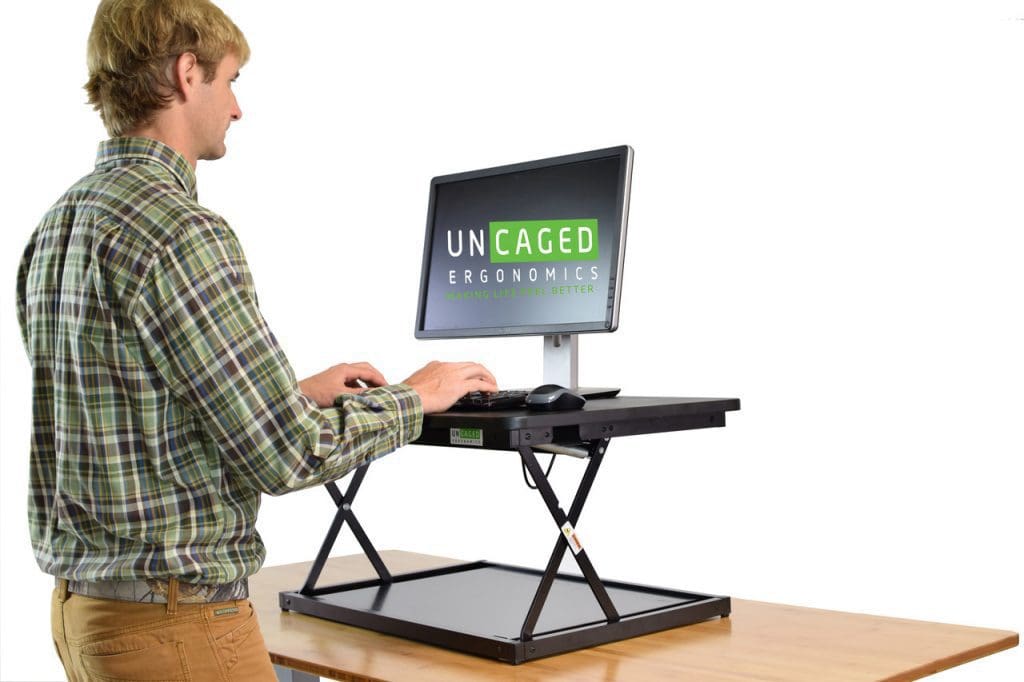Business Storage Stories:
A Conversation with Uncaged Ergonomics Founder John Failing
Recently, I had a conversation with one of our business storage customers, John Failing. John is the founder, President, and CEO of Uncaged Ergonomics, one of the leading providers of ergonomic products for the office and home. John explains how the business started and why they needed storage at Montgomery Self-Storage in Oxnard, CA.
Q: How and why did you get into the business of creating ergonomic furniture?
John: By the time I entered graduate school, years of my life had been spent hunching over textbooks. The painfully poor posture detracted me from learning, leading to frustration and a realization that I should finally listen to the age-old advice “sit up straight.” My search for an affordable, adjustable height and tilt book stand was a dead-end; so, I set off on a mission to create the product I needed to make studying less physically painful. While in school, Uncaged Ergonomics launched our first product line – the WorkEZ Series of adjustable height and angle reading & laptop stands.
Similar to the organic food movement, “ergonomic furniture” was a niche offspring of the overall furniture market when Uncaged Ergonomics was created. After a few tough, boot-strapped years, modern research lead to consumer education about the health and productivity benefits of ergonomic furniture, which stoked demand for these products. We began at a time when there was little consumer awareness about the benefits of ergonomic furniture. But as consumer knowledge increased, demand for our products grew which allowed us to invest in innovating, value-driven office and computer furniture.
Q: How long have you been in business? How many ergonomics products have you developed?
John: Uncaged Ergonomics was created in 2010. Over the past decade, we’ve been able to create and bring to market about 30 ergonomics products.
Q: Where did you sell your products originally?
John: As students with no retail, startup, or business experience, we certainly fumbled significantly in the early years as we learned by both doing and trial-and-error how, where, and to whom we could sell our creations. At first, we started with a simple website and mostly fruitless cold calling to try and grab the attention of retailers. With slow sales and too much inventory, we tried face-to-face selling by attending events, shows, and eventually setting up temporary mall kiosks – all while continuing to maintain a growing e-commerce presence.
Q: Which product is your most successful?
John: We’ve experienced the ebbs and flows of consumer demand and the entire product life cycle – going from a novel creation to a relatively “common” product as competitors pop up drawing inspiration from our creations. Recently, one of our most in-demand products is our KT1 ergonomic keyboard tray – a patented, commercial-grade, under-desk keyboard tray that was created to deliver the ultimate combination of useful ergonomic features and value to consumers.
We strive to bring two to four new products to market annually and are excited about our newest creation, the patent-pending CD4 laptop riser and standing desk – a compact desktop stand that lets you adjust the height and tilt of your laptop to work more comfortably sitting and quickly convert to standing.
Q: I see that you now have your products in many of the nation’s largest retailers. Which was the first big retailer to carry your products?
John: Before the e-commerce boom, we were fortunate to grab the attention of some mid-sized and regional retailers like Hammacher Schlemmer, Microcenter, and Fry’s Electronics. Our first big-box relationship was with Staples – a partnership that continues to flourish. We value relationships with retailers and re-sellers and have seen that these partnerships deliver exceptional value and selection to consumers. Currently, we work with hundreds of small to big-box retailers and are always looking to expand our presence.
Q: I imagine that you’ve got some great stories of how you’ve helped solve customers’ challenging ergonomic issues. Are there any that stand out in particular?
John: Probably the most rewarding customer solutions that we provided were (and are) supplying our WorkEZ laptop stands to handicapped individuals to use in wheelchairs and at home.
Due to the specific nature of our products, we’re often able to pinpoint one of our creations that will effectively solve a customer issue. However, we frequently interact with customers that have unique environments requiring creative and customized solutions. For example, we’ve had numerous cases where customers are looking to convert antiquated, clunky desks or furniture into a somewhat ergonomic setup rather than start fresh with a modern setup. One request that stands out is a customer that was trying to convert what appeared to be a low, two-tiered counter with cabinets hindering the height range into a sit/stand workspace. We were able to combine products and parts of products to create a customized solution that, while not a candidate for the “ergonomic desk of the year”, did solve the customer’s issue.
Q: What piece of advice would you give to people working in an office setting regarding their ergonomic set-up?
John: Separate the adjustability of your keyboard and monitor. Having the proper distance between screens (which should be at about eye-height) and keyboards (which should be just below elbow-height) will make a world of difference for your posture, health, and focus whether you’re working at a traditional sitting desk or a standing desk. This can be easily and affordably accomplished with a monitor stand and/or keyboard tray.
Beyond that, there’s a plethora of modern research that highlights the benefits of moving more during the workday rather than sitting stationary for hours on end. Accomplishing more movement can be as simple as periodically standing up and stretching, taking a quick stroll, or through the investment in some modern “active furniture” such as a Wobble Stool, standing desk, or balance board – all of which are designed to allow gentle, non-distracting movement while you’re getting work done.
Q: Why did you need extra storage at Montgomery Self Storage?
John: Uncaged Ergonomics is a small business that designs, manufactures, and distributes our products. From the outset, we had a minimal space requirement for inventory storage and felt that storage facilities would affordably and effectively meet our storage requirements. Without a long-term lease, we have the flexibility to manage space efficiently – quickly expanding/contracting space as needed – and have reduced our long-term financial risk.
The concept of using a storage facility rather than a traditional commercial warehouse space mostly derived from our boot-strapped philosophy and the original uncertainty about the long-term viability of our business. We were fortunate to find a storage location that supported business tenants and had larger units with tall ceilings that allowed us to efficiently store inventory. We started with a small unit, grew into a larger unit, and then subsequently multiple large units.
Q: Has your storage experience been a good one?
John: In hindsight, our decision to use a storage facility rather than a traditional commercial warehouse was a smart move. We’ve reduced annual warehouse rent by efficiently matching rentable square footage to our inventory requirements and have maintained the flexibility to increase or decrease space plus move to a larger space when the time is right. I have to give kudos to our current location (Montgomery Self-Storage), because they designed the facility to have larger square footage units with taller inside heights that are perfect for commercial tenants. Plus, they have been immensely supportive of commercial tenants and allowed us to access our units daily.
Q: What are the company’s goals for the future?
John: To continue innovating office, computer, and home furniture while steadily growing sales to reduce the going concern risk so we can provide long-term, sustainable, rewarding careers to employees and contractors who work with us.

About the Author: Derek Hines
Digital Marketing Specialist
Derek is originally from the great state of Wisconsin (go Badgers), but is slowly becoming a Pacific Northwesterner. As part of the Digital Marketing team, he writes extensively on storage, moving and life for West Coast Self-Storage, based in Everett, Washington.

